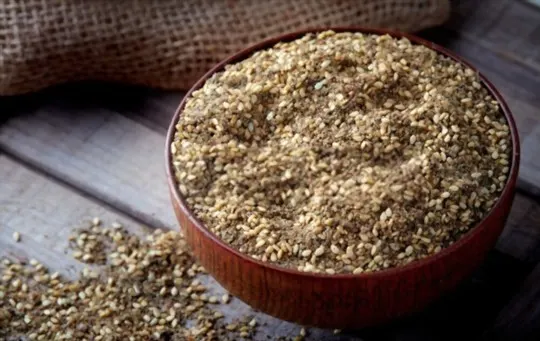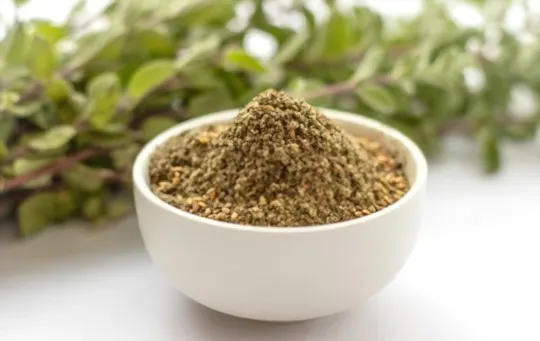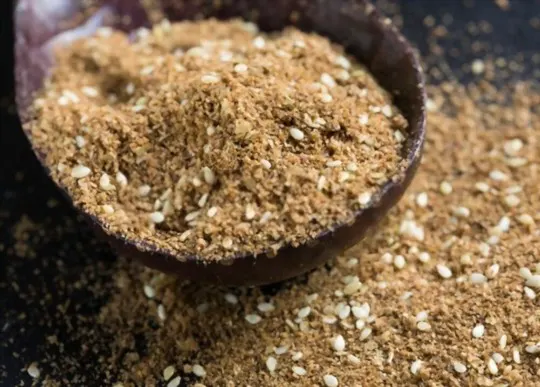When you’re out shopping for spices and stumble upon one called za’atar, you might burst with millions of questions.
Originating from the Middle East, za’atar is a family of herbs and also a spice blend.
The question remains, how do you use it, and what kind of taste can you expect? If you’re intrigued to learn more about za’atar and what does za’atar taste like, we’re here to answer all your questions.
Today, we’ll tell you everything you need to know about this flavorsome ingredient and how to use it for cooking something delicious.
Keep reading to know more.
What is Za’atar?

As an herb, za’atar (or Bible hyssop in English) is a variety of wild thyme.
However, za’atar is commonly known for being a seasoning.
It’s usually a combination of thyme with sesame seeds, sumac, and sometimes, oregano.
It shouldn’t be surprising to know that za’atar has several health benefits.
The three main ingredients found in za’atar are loaded with organic compounds.
These are rich in antioxidants that prevent harm to human cells.
Even though za’atar is primarily common in the Mediterranean and Middle East, it’s one of the best and most unique seasonings you’ll find worldwide.
Taste-wise, you’ll find it more profound than thyme you get in North America or rosemary.
The mixture of all the aromatic ingredients helps give za’atar its exceptional taste.
Full of complex flavors, it’ll be hard to stop using this spice on your food when you’re cooking next time.
What Does Za’atar Taste Like?

Za’atar has an unusually herby flavor.
It is crunchy, savory, tangy, and earthy all at once.
This is all thanks to the blend of several ingredients packed in the condiment.
As for the taste of za’atar, we can say that it resembles that of a kebab you’ll find in Morocco- distinct and savory.
Remember that not all za’atar tastes the same.
From the quality to the texture and taste, the blends will differ.
One way to get your hands on high-quality za’atar is to read through the label thoroughly.
Technically, all the ingredients should be naturally sourced.
Also, ensure that the za’atar in question is green in color.
Adding za’atar to grilled vegetables or using it as a spice rub on meat makes for an excellent choice.
If you can’t find za’atar, you can add sesame seeds (make sure they’re roasted) and lemon zest as substitutes.
If you want to try a new food experiment, adding za’atar to your food will do the trick.
The distinct taste of this spice will undoubtedly awaken your taste palate.
A quick tip: try blending this spice in olive oil into a sauce.
Doing so will immediately enhance its taste to the maximum.
Not only its taste but even its texture will feel different.
This is when you’ll know that the spice is jam-packed with bursting flavors.
How to Serve and Use Za’atar?

Commonly referred to as the King of Herbs due to its versatility, there are several ways to serve za’atar.
You’ll be surprised to know how delicious it tastes when you add it to your favorite everyday foods.
The options are endless if you plan to use this spice when cooking.
You could dust some za’atar on top of hummus, use it while baking flatbread, mix it with tahini or olive oil to make a delicious dip, or rub it on meat.
While roasting chicken, do away with the common herbs and lemon and use za’atar.
Its intense yet earthy flavor will have you and your family members salivating for more.
You could also try adding za’atar to your favorite Western dishes.
After all, this spice isn’t only limited to Middle Eastern cuisine.
Consider using this spice while making scones, pizzas, or chicken cutlets.
Za’atar can also be a perfect accompaniment for appetizers.
If you love goat cheese, don’t shy away from rolling some on this spice and coupling it with crackers.
You’ll be smacking your lips as you gloat over the discovery of this tasty treat.
From vegetables to rice, pasta, and salads, sprinkling some za’atar on top of these foods is worth trying.
If you don’t want to mess it up, look up za’atar recipes online.
You’re sure to find one that’s easy to make.
Conclusion
Whether you use it for baking, roasting, or cooking, za’atar is an all-rounder ingredient you can’t ignore.
Even though it’s native to the Middle East, the sky is the limit when adding it to your daily food.
Being a multipurpose seasoning, you could never go wrong with za’atar in terms of usage.
The only thing you need to keep in mind is to ensure the za’atar you get from the store is of the best quality.
Once you have this ingredient, you can start experimenting in the kitchen and delight your family members with yummy treats.

Leave a comment